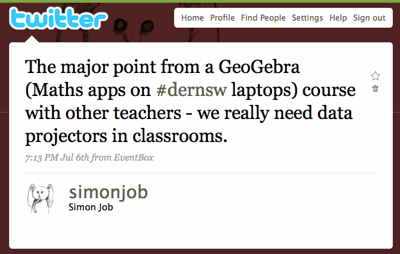Using GeoGebra
Wednesday, 22 July 2009 | 1 Comment
This article is not a “how-to” but rather some thinking about using GeoGebra (a discussion starter maybe).
As noted previously, I went to a GeoGebra course the other day. There was lots of how-to in the course, but the one disappointing part was the small amount of discussion of using this software in class. I think that would have been of greater benefit. I see a lot of teachers getting excited about widgets rather than thinking about how they will use them with a class. Maybe they are thinking about it, but just not talking about it or sharing what they are doing… It seemed the same with this GeoGebra course.
There was brief discussion, but it came down to this one point I wrote on Twitter:
Aside from the need for data projectors in our classrooms, here are some of the ways I can see GeoGebra being used in the classroom. I’m thinking about this in terms of looking at angles created by a transversal cutting parallel lines – it was a topic I had just taught before going to this course.
Demonstration
Using GeoGebra to demonstrate a concept seems to be the most obvious application. Widgets to demonstrate the angle properties when a transversal cuts parallel lines can be whipped up in minutes (alternate, corresponding, cointerior). These, would be teacher led, although with their own laptops, obviously the students could play with them as well.
How is this better to doing a paper-based activity? For starters, the measuring is accurate – you know the problem, students measure the angles in a triangle to discover they add to 179°! Also, not being a static representation, students can see that the property holds for various lines, triangles etc.
Discovery
A step-up from Demonstration might be to make a simpler GeoGebra file (or even get them to create it from scratch*) with just the parallel lines and a transversal, and get them to either 1. measure pairs of angles you point out, or 2. to work blindly until they find relationships between pairs of angles. Not sure of the effectiveness of that though, certainly I would need to provide a scaffold to my classes.
*Side note: there also needs to be some discussion about the benefits of students learning to construct things in GeoGebra.
Consolidation
One way I’ve used dynamic geometry in the past was to create a one lesson consolidation activity, where students construct or used pre-constructed objects to investigate properties.
Extra thoughts that aren’t really conclusions, because I haven’t concluded anything yet
First up, when it comes down to it, technology is an extra. As this poll suggests, good teaching can happen without technology, but as the second poll points out, we need to be using technology. GeoGebra is a great tool to supplement and extend existing teaching and learning.
To answer my own side note above about the benefits of students learning to construct things in GeoGebra. I think we need to teach how to use GeoGebra for construction, because it provides the students with another tool to use outside of class, to construct and investigate in their own time.
How do we use GeoGeobra in the classroom without a projector? With difficulty.
This post is not quite what I envisaged when I set out, but it has been written over the course of a week (with the beach across the road being a distraction). But, hopefully I can expand later as this term proceeds, and look forward to hearing your thoughts in the comments.
Posted in • Reflection • Software • GeoGebra • Technology • Digital Education Revolution • Laptops 4 Learning • Tools | Short URL: http://mths.co/1584
Post a comment
Commenting is not available in this channel entry.New Subscribe to the …
MathsLinksemail newsletter
Get updates…
About
Simon Job — eleventh year of teaching maths in a public high school in Western Sydney, Australia.
MathsClass is about teaching and learning in a maths classroom. more→
Archive
Elsewhere
 @simonjob
@simonjob
updates via  @mathslinks
@mathslinks
Recently read/found.
Being a Vector is not Mutually Exclusive – Ringo Mok
maths vectorsInstagram
Gcf howie_hua maths


Comments